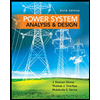As you know, if you put two DC voltage sources in series, you can provide a larger voltage to an application. For example, two 1.5V AA batteries in series provides 3V. You can do the same thing with AC voltage, though the situation is more complicated. Suppose you have two AC voltage sources that have the same amplitude and frequency, but are out of phase with one another. In mathematical terms, one of the voltage functions looks like V0⋅sin(ωt) and the other looks like V0⋅sin(ωt+δ). δ is referred to as a phase offset and is in radians. If you add those sources together, what's the rms voltage of the resulting signal? Let V0=23 V, ω=280 rad/s, and δ=0.8 rad. You'll probably need to work from the definition of root-mean-square. You can get a short, tidy algebraic answer by using trig identities. I managed to find the answer a different way, but can someone please show me how to solve this using trig identities?
As you know, if you put two DC voltage sources in series, you can provide a larger voltage to an application. For example, two 1.5V AA batteries in series provides 3V. You can do the same thing with AC voltage, though the situation is more complicated. Suppose you have two AC voltage sources that have the same amplitude and frequency, but are out of phase with one another. In mathematical terms, one of the voltage functions looks like V0⋅sin(ωt) and the other looks like V0⋅sin(ωt+δ). δ is referred to as a phase offset and is in radians. If you add those sources together, what's the rms voltage of the resulting signal? Let V0=23 V, ω=280 rad/s, and δ=0.8 rad. You'll probably need to work from the definition of root-mean-square. You can get a short, tidy algebraic answer by using trig identities.
I managed to find the answer a different way, but can someone please show me how to solve this using trig identities?
Trending now
This is a popular solution!
Step by step
Solved in 2 steps




